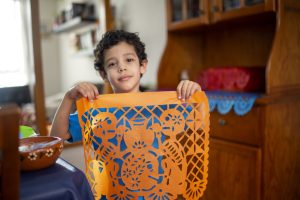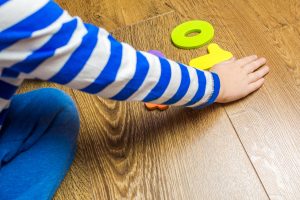Families play an important role in helping young children learn about numbers, counting, and other math skills. With their families’ help, children can learn to enjoy math from an early age. And the best news is that one way of learning about math at home is through playing games. Card games, for example, are a great way to have fun with children while learning math—and all you need is a deck of cards!
In this blog, we introduce you to 10 family card games we designed for young children between the ages of about 4 to 7 years old, but older children will enjoy these games, too. We hope that families will use our games as a starting point for creating their own games and discovering other ways to have fun with math at home.
What’s Special About Our Card Games?
Beth Casey and Eric Dearing, professors from the Lynch School of Education and Human Development at Boston College, created the family card games to build young children’s math skills. The games were developed in collaboration with the San Francisco-based organization, Tandem, Partners in Early Learning.
The math concepts in these card games are designed to help children begin to understand the meaning of numbers and how they relate to one another. The games are ordered from easier to more advanced in a way that helps children work on math concepts that have been shown to be critical for the development of arithmetic skills. [1, 2, 3]
What Math Skills Are Taught Through the Card Games?
Children can explore these math concepts while playing the card games:
Identifying which number is larger or smaller. “Which number is larger, six or four?” Answering this question involves comparing the magnitude of numbers in relation to one another and helps children to understand that numbers are not only symbols but also represent a certain quantity that can be compared in size with other number symbols. This understanding gives them a toolbox for a host of more advanced math skills leading to addition and subtraction. [3] Comparing numbers can be tricky for young children, especially when larger numbers are very close together. [4] For example, it takes a young child longer to decide whether eight is larger than seven than it does for them to decide whether eight is larger than four.
Ordering numbers between one and 10 from small to large. “Can you put these numbers in order from smallest to largest: 4, 9, 6, 2, 7?” Putting number symbols in order from smallest to largest provides another way of thinking about the magnitude of numbers in relation to one another. Again, this is an important foundation for learning and doing addition. [5] Research has shown that even infants have a basic sense that there is an order to numbers. [6] However, being able to put numbers in order takes time and practice to develop. [7] One reason is that it can be hard for young children (and even adults!) to keep track of a lot of information at once. [8]
Adding with small numbers.“If you have seven cards and I have five cards, how many cards do we have altogether?” Learning to add represents a major milestone in mathematical learning. It takes children years and lots of practice to master simple addition. [9] Not only will they use these skills in everyday life, but they will also continue to build on these skills for years to come as they learn increasingly complex arithmetic operations such as subtraction, multiplication and division, algebra, and more.
More advanced arithmetic. “If you two take away from seven, what are you left with?” Subtraction is an important skill in early arithmetic. You could help children to think about addition with questions such as, “Two plus what number equals seven?” Solving these types of problems help children understand the relation between addition and subtraction.
Picking a Card Game for the Child’s Math Level
Along with the games, we created a simple way for families to decide which level of games to start with and what to move on to as the child learns. This is important because research shows children’s learning happens when they are provided with just the right amount of challenge. Within the games, players can raise or lower the challenge based on the child’s skill level using variations provided for each game. There are also hints provided for each game that can be used to give children the appropriate amount of support and help.
Playing the Games
Ready to play? First, you’ll need to find a standard deck of playing cards. You can buy them in drug stores everywhere and they are inexpensive. Check out this introduction to playing cards for information about types of playing cards and common card game terms and definitions.
Each card game includes instructions for playing and a link to a short video explaining the rules of the game. The games are also available in Spanish.
To make the card games even more engaging, read this short story together before you begin playing. Every game comes with its own mini story that builds on this one. Before you play a new game, read the game’s mini story to make playing more fun!
The math skills taught through these card games take practice. What better way to practice math skills than with a game! So don’t play the card game just once. Play it many times before you move on to the next card game.
[1] Lyons, I. M., & Ansari, D. (2015). Numerical order processing in children: From reversing the distance‐effect to predicting arithmetic. Mind, Brain, and Education, 9(4), 207-221.
[2] Duncan, G. J., Dowsett, C. J., Claessens, A., Magnuson, K., Huston, A. C., Klebanov, P., … & Sexton, H. (2007). School readiness and later achievement. Developmental psychology, 43(6), 1428.
[3] Jordan, N. C., Kaplan, D., Locuniak, M. N., & Ramineni, C. (2007). Predicting first‐grade math achievement from developmental number sense trajectories. Learning Disabilities Research & Practice, 22(1), 36-46.
[4] Holloway, I. D. & Ansari, D. (2009) Mapping numerical magnitudes onto symbols: The numerical distance effect and individual differences in children’s mathematics achievement. Journal of Experimental Child Psychology, 103, 17-29.
[5] Lyons, I. M., & Beilock, S. L. (2011). Numerical ordering ability mediates the relation between number-sense and arithmetic competence. Cognition, 121(2), 256-261.
[6] Brannon, E. M. (2002). The development of ordinal numerical knowledge in infancy. Cognition, 83(3), 223–240.
[7] Spaepen, E., Gunderson, E. A., Gibson, D., Goldin-Meadow, S., & Levine, S. C. (2018). Meaning before order: Cardinal principle knowledge predicts improvement in understanding the successor principle and exact ordering. Cognition, 180, 59-81.
[8] Gathercole, S. E., Pickering, S. J., Ambridge, B., & Wearing, H. (2004). The structure of working memory from 4 to 15 years of age. Developmental Psychology, 40, 177–190.
[9] Huttenlocher, J., Jordan, N. C., & Levine, S. C. (1994). A mental model for early arithmetic. Journal of Experimental Psychology: General, 123(3), 284.



